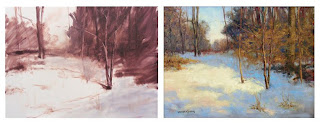 This is a photo by Lumiere Technology in Paris showing the site of a fingerprint on a painting that art experts now believe is a newly discovered Leonardo da Vinci. Peter Paul Biro, a Montreal-based forensic art expert, said that a fingerprint on what was presumed to be a 19th-century German painting of a young woman has convinced art experts that it's actually a da Vinci.
This is a photo by Lumiere Technology in Paris showing the site of a fingerprint on a painting that art experts now believe is a newly discovered Leonardo da Vinci. Peter Paul Biro, a Montreal-based forensic art expert, said that a fingerprint on what was presumed to be a 19th-century German painting of a young woman has convinced art experts that it's actually a da Vinci."Leonardo used his hands liberally and frequently as part of his painting technique. His fingerprints are found on many of his works," Biro said. "I was able to make use of multispectral images to make a little smudge a very readable fingerprint."
The unsigned chalk, ink and pencil drawing, known as "La Bella Principessa," is believed to be the daughter of a 15th century Milanese duke, and is now valued at $150 million.
If da Vinci were alive today, I think he'd get a kick out of the idea of using scientific methods such as these to confirm the validity of paintings.
For a full story follow this link:
http://news.yahoo.com/s/ap/cn_canada_da_vinci_discovery




